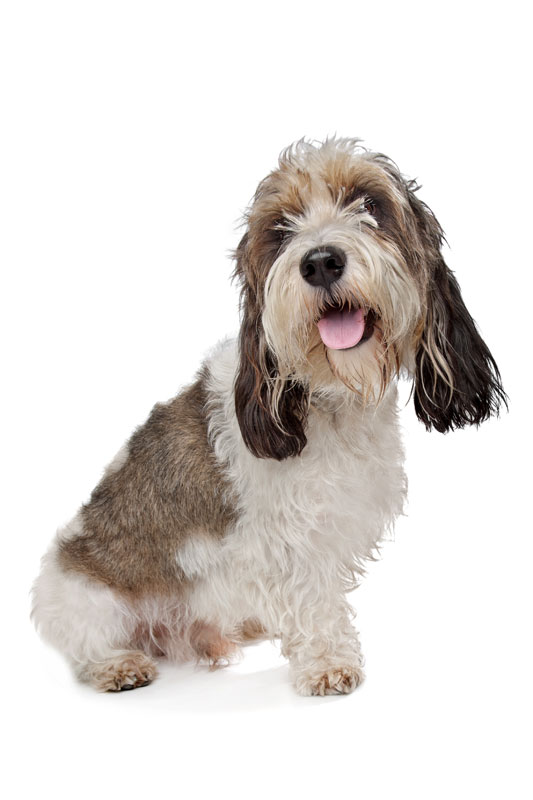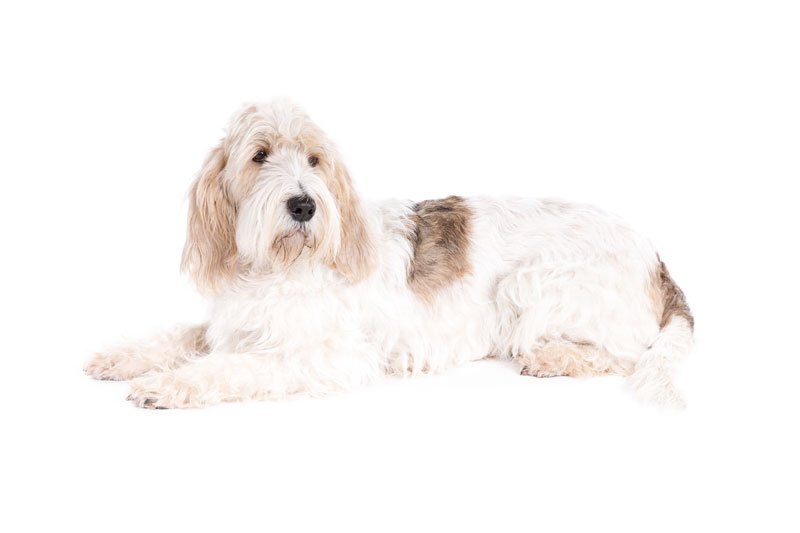Super User
Gran Mastín de Borínquen
The Gran Mastín de Borinquen, also known as the Puerto Rican Mastiff, Mastín Borincano, Becerillo de Borinquen and Perro Barsino de Hacienda, is the only breed native to the island of Puerto Rico.
The Borinquen Mastiff is a blend of Spanish Mastiff, traditional island dogs (Perros Jíbaros) and Latin American Molossers, all brought to the island for protection from colonial times until the early 20th century.
Grand Anglo-Français Blanc et Noir
The Grand anglo-français blanc et noir (FCI No.323) translated into English as the Great Anglo-Francais White and Black Hound, is a dog breed of dog used in hunting as a scenthound, usually in packs. It is one of the Anglo-French hound breeds which were created by crossing French scenthounds with English (Anglo) foxhounds.
Health and temperament
No unusual health problems or claims of extraordinary health have been documented for this breed. Temperament of individual dogs may vary, but in general dogs bred to be pack hunting dogs do not make good pets.
Grand Anglo-Français Blanc et Orange
The Grand anglo-français blanc et orange (FCI No.324) translated into English as the Great Anglo-Francais White and Orange Hound, is a dog breed of dog used in hunting as a scenthound, usually in packs. It is one of the Anglo-French hound breeds which were created by crossing French scenthounds with English (Anglo) foxhounds.
Health and temperament
No unusual health problems or claims of extraordinary health have been documented for this breed. Temperament of individual dogs may vary, but in general dogs bred to be pack hunting dogs do not make good pets.
Grand Anglo-Français Tricolore
The Grand Anglo-Francais Tricolore is a breed of dog used in hunting as a scenthound, usually in packs. It is one of the Anglo-French hound breeds which were created by crossing French scenthounds with English (Anglo) foxhounds.
Health and temperament
This large Anglo-French hound requires an immense amount of exercise. They are normally kept in large packs in rural areas and may not adapt well to city or family life, although they are said to be good natured. Letting them off the lead may be hazardous as the hunting instinct is very high.
Grand Basset Griffon Vendéen
The Grand Basset Griffon Vendéen is a dog breed from France.
History
The Grand Basset Griffon Vendéen is derived, like all bassets, from hounds of superior size, in this case the Grand Griffon. The first selections were made at the end of the 19th century by the Comte d'Elva who was looking for subjects with "straight legs". But it was Paul Dézamy who was especially responsible for fixing the type. He had understood that in order to catch a hare, dogs of a certain size were needed. He fixed the size at about 43 cm. Today used primarily when hunting with a gun, it is capable of hunting all furry game, from the rabbit to the wild boar. A team of Grand Bassets won the 5th edition of the European Cup for hare.
Health
The UK Kennel Club conducted a health survey of Basset Griffon Vendéens (Petit and Grand varieties combined) in 2004. This is apparently the only completed health survey (as of July 16, 2007)[3] that might include Grand Basset Griffon Vendéen, but it is unclear what proportion of dogs in the survey were Grand Basset Griffon Vendéens instead of the more common Petit.
Longevity
Average longevity of 76 deceased Basset Griffon Vendéens (varieties combined) in the 2004 UK Kennel Club survey was 12.1 years (maximum 17.3 years). Leading causes of death were cancer (33%), old age (24%), and cardiac (7%).
Compared to surveyed longevities of other breeds of similar size, Basset Griffon Vendéens have a typical or somewhat higher than average life expectancy.
Among 289 live Basset Griffon Vendéens (varieties combined) in the 2004 UKC survey, the most common health issues noted by owners were reproductive, dermatologic (dermatitis and mites), and aural (otitis externa, excessive ear wax, and ear mites).
Grand Griffon Vendéen
A Grand Griffon Vendéen is a breed of hunting dog originating in France. It existed as early as the 16th Century, and was the first of the Vendée griffons to be bred. It is a descendant of the Canis Segusius used by the Gauls, through the so-called King's whites and the Griffon Fauve de Bretagne, which is also an ancestor of the Basset Fauve de Bretagne.There are also several other breeds of Griffons from Vendée, all of them smaller: the Briquet Griffon Vendéen, and the Grand Basset Griffon Vendéen and Petit Basset Griffon Vendéen. Related Griffon breeds include the Basset Fauve de Bretagne, the Griffon Bleu de Gascogne and the Griffon Nivernais.
Great Dane
The Great Dane is a German breed of domestic dog (Canis lupus familiaris) known for its giant size. The name of the breed in Germany is Deutsche Dogge (German Mastiff). They are known for their enormous bodies and great height. The Great Dane is one of the world's tallest dog breeds; the current world record holder, measuring 112cm from paw to shoulder, is "Zeus". Their large size belies their friendly nature, as Great Danes are known for seeking physical affection with their owners.
History
Dogs resembling the Great Dane have been seen on Egyptian monuments dating back to 3,000 BC.
The large boarhound or Molosser continues to appear throughout ancient Greece in subsequent centuries right up to the Hellenistic era.
The Molossian hound, the Suliot dog and specific imports from Greece were used in the 18th century to increase the stature of the boarhounds in Austria and Germany and the wolfhounds in Ireland.Bigger dogs are depicted on numerous runestones in Scandinavia, on coinage in Denmark from the 5th Century AD and in the collection of Old Norse poems, known in English as Poetic Edda. The University of Copenhagen Zoological Museum holds at least seven skeletons of very large hunting dogs, dating from the 5th Century BC going forward through to the year 1000 AD.
Health
Great Danes, like most giant dogs, have a fairly slow metabolism. This results in less energy and less food consumption per pound of dog than in small breeds. Great Danes have some health problems that are common to large breeds, including bloat (gastric dilatation volvulus(GDV)). The average life span of Great Danes is 6 to 8 years; however, some Great Danes have been known to reach 10 years of age or more. Like many larger breeds, Great Danes are at particular risk for hip dysplasia.
Dilated cardiomyopathy (DCM) and many congenital heart diseases are also commonly found in the Great Dane, leading to its nickname: the Heartbreak breed, in conjunction with its shorter lifespan. Great Danes also may carry the merle gene, which is part of the genetic makeup that creates the harlequin coloring. The merle gene is an incomplete dominant, meaning only one copy of the gene is needed to show the merle coloring; two merle genes produce excessive white markings and many health issues such as deafness, blindness, or other debilitating ocular issues. Great Danes can also develop something called "wobblers disease" that can affect their vertebral column. Since these dogs do grow at a rapid rate, the bones in their vertebae can push up against the spinal cord and cause a little bit of weakness in the legs. This can be treated with surgery or it may straighten itself out.
Great Pyrenees
The Pyrenean Mountain Dog, known as the Great Pyrenees in North America, is a large breed of dog used as a livestock guardian dog. It should not be confused with the Pyrenean Mastiff. The Great Pyrenees is a very old breed that has been used for hundreds of years by shepherds, including those of the Basque people, who inhabit parts of the region in and around the Pyrenees Mountains of southern France and northern Spain. One of the first descriptions of the breed dates from 1407, and from 1675 the breed was a favorite of Louis, Dauphin of France (1661–1711) and other members of the French aristocracy. By the early nineteenth century there was a thriving market for the dogs in mountain towns, from where they would be taken to other parts of France. It was developed to be agile in order to guard sheep on steep, mountainous slopes.As late as 1874 the breed was not completely standardized in appearance, with two major sub-types recorded, the Western and the Eastern. They are related to several other large white European livestock guardian dogs (LGD), including the Italian Maremma Sheepdog, Kuvasz (Hungary), Akbash Dog (Turkey) and Polish Tatra or Polski Owczarek Podhalański, and somewhat less closely to the Newfoundland and St. Bernard. According to the Great Pyrenees Club of America, the Great Pyrenees is naturally nocturnal and aggressive with any predators that may harm its flock. However, the breed can typically be trusted with small, young, and helpless animals of any kind due to its natural guardian instinct. The Great Pyrenees breed has experienced a dramatic fall off in the number of U.S. AKC breed registrations from 2000 to 2010. The breed was ranked at #45 in 2000 and by 2010 Great Pyrenees had dropped to #71. Other large breeds in the same working group classification, Newfoundland and St. Bernard, have fared far better in maintaining their breed rankings. In 2010 Newfoundland and St. Bernard were ranked #44 and #45 respectively. In the one year period alone from 2009-2010, the Great Pyrenees experienced a drastic 7-point drop in registrations. Although AKC rankings are not a true gauge of a breed's popularity, the change in the AKC rankings may reflect a realignment in the sources of the dogs available to the general public. A large number of dogs coming from shelters in the South and Midwest U.S., are now available through rescue societies, as well as the introduction of other breed registry services may have played a part in the continuing decline in Great Pyrenees' AKC registrations.
Greater Swiss Mountain Dog
The Greater Swiss Mountain Dog is a dog breed which was developed in the Swiss Alps. The name Sennenhund refers to people called Senn or Senner, dairymen and herders in the Swiss Alps. Greater Swiss Mountain Dogs are almost certainly the result of Indigenous (ecology) dogs canine reproduction with large Mastiff types brought to Switzerland by foreign settlers. At one time, the breed was believed to have been among the most popular in Switzerland. The breed was also used as a butcher's dog, having been "popular with butchers, cattle dealers, manual workers and farmers, who used them as guard dogs, droving or draught dogs and bred them as such." Its popularity as a draft dog led to the nickname "the poor man's horse". By the 19th century, the ancestors of the modern Greater Swiss Mountain Dog were widely used in central Europe by farmers and tradesmen. to an advocate of the Swiss mountain dogs, geology professor Albert Heim (April 12, 1849 – August 31, 1937).
Secondary theory
There is little information about the Greater Swiss Mountain Dog written before 1907. Until 1913, it was only mentioned in reports by exhibition judges, such as Dr. Albert Heim, who is credited with introducing them into official dog breeding. Raber is sure the dogs were present in 1900 as draft dogs for peddlers and people going to market, watch dogs for farmers and drover’s dog for butchers; they were rarely tri-colored. Greater Swiss Mountain Dog was featured in the front page of the Wall Street Journal as he prepared to compete at the Westminster dog show. According to the AKC, Greater Swiss Mountain Dogs are 88th in popularity as a breed.
Greek Harehound
The Greek Harehound (FCI No. 214) is a rare breed of dog that only comes in a black and tan color originally bred as a scent hound for Tracking and chasing hare in Southern Greece.




